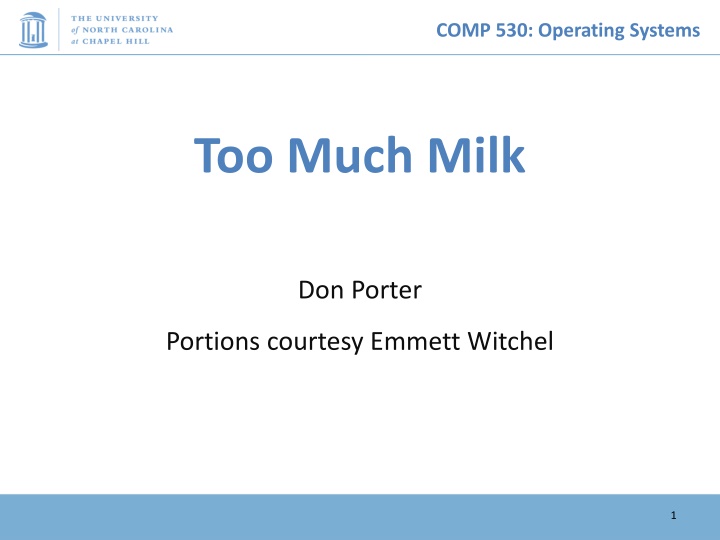
Understanding Operating Systems Concurrency Challenges
Explore the complexities of mutual exclusion, thread coordination, and synchronization in operating systems. Learn about critical sections, shared data structures, and formalizing solutions to concurrency issues. Understand the importance of correctness conditions and synchronization code design.
Download Presentation

Please find below an Image/Link to download the presentation.
The content on the website is provided AS IS for your information and personal use only. It may not be sold, licensed, or shared on other websites without obtaining consent from the author. If you encounter any issues during the download, it is possible that the publisher has removed the file from their server.
You are allowed to download the files provided on this website for personal or commercial use, subject to the condition that they are used lawfully. All files are the property of their respective owners.
The content on the website is provided AS IS for your information and personal use only. It may not be sold, licensed, or shared on other websites without obtaining consent from the author.
E N D
Presentation Transcript
COMP 530: Operating Systems Too Much Milk Don Porter Portions courtesy Emmett Witchel 1
COMP 530: Operating Systems Critical Sections are Hard, Part 2 The following example will demonstrate the difficulty of providing mutual exclusion with memory reads and writes Hardware support is needed The code must work all of the time Most concurrency bugs generate correct results for some interleavings Designing mutual exclusion in software shows you how to think about concurrent updates Always look for what you are checking and what you are updating A meddlesome thread can execute between the check and the update, the dreaded race condition
COMP 530: Operating Systems Thread Coordination Too much milk! Jill Jack Look in the fridge; out of milk Go to store Buy milk Arrive home; put milk away Look in fridge; out of milk Go to store Buy milk Arrive home; put milk away Oh, no! Fridge and Milk are Shared Data Structures
COMP 530: Operating Systems Formalizing Too Much Milk Shared variables Look in the fridge for milk check a variable Put milk away update a variable Safety property At most one person buys milk Liveness Someone buys milk when needed How can we solve this problem?
COMP 530: Operating Systems How to think about synchronization code Every thread has the same pattern Entry section: code to attempt entry to critical section Critical section: code that requires isolation (e.g., with mutual exclusion) Exit section: cleanup code after execution of critical region Non-critical section: everything else There can be multiple critical regions in a program Only critical regions that access the same resource (e.g., data structure) need to synchronize with each other while(1) { Entry section Critical section Exit section Non-critical section }
COMP 530: Operating Systems The Correctness Conditions Safety Liveness Some thread that enters the entry section eventually enters the critical region Even if some thread takes forever in non-critical region Bounded waiting A thread that enters the entry section enters the critical section within some bounded number of operations. Failure atomicity It is OK for a thread to die in the critical region Many techniques do not provide failure atomicity Only one thread in the critical region while(1) { Entry section Critical section Exit section Non-critical section }
COMP 530: Operating Systems Solution #0 while(1) { if (noMilk) { if (noNote) { // check if roommate is getting milk leave Note; //Critical section buy milk; remove Note; // Exit section } // Non-critical region } // check milk (Entry section) Is this solution 1. Correct 2. Not safe 3. Not live 4. No bounded wait 5. Not safe and not live W hat if we switch the order of checks? It works sometime and doesn t some other times Threads can be context switched between checking and leaving note Live, note left will be removed Bounded wait ( buy milk takes a finite number of steps)
COMP 530: Operating Systems Solution #1 turn := Jill // Initialization while(1) { while(turn Jack) ; //spin while (Milk) ; //spin buy milk; // Critical section turn := Jill // Exit section // Non-critical section } while(1) { while(turn Jill) ; //spin while (Milk) ; //spin buy milk; turn := Jack // Non-critical section } Is this solution 1. Correct 2. Not safe 3. Not live 4. No bounded wait 5. Not safe and not live At least it is safe
COMP 530: Operating Systems Solution #2: Peterson s Algorithm Variables: ini: turn: thread Ti is executing , or attempting to execute, in CS id of thread allowed to enter CS if multiple want to Claim: We can achieve mutual exclusion if the following invariant holds before thread i enters the critical section: (( in0 (in0 turn = 1)) in1) (( in1 (in1 turn = 0)) in0) ((turn = 0) (turn = 1)) = false {( inj (inj turn = i )) ini} Intuitively: j doesn t want to execute or it is i s turn to execute
COMP 530: Operating Systems Peterson s Algorithm in0 = in1 = false; Jack while (1) { in0:= true; turn := Jill; while (turn == Jill && in1) ;//wait Critical section in0 := false; Non-critical section } Jill while (1) { in1:= true; turn := Jack; while (turn == Jack && in0);//wait Critical section in1 := false; Non-critical section } Spin! turn=Jill, in0 = true turn=Jack, in0 = true, in1:= true turn=Jack, in0 = false, in1:= true Safe, live, and bounded waiting; but only 2 threads
COMP 530: Operating Systems Too Much Milk: Lessons Peterson s works, but it is really unsatisfactory Limited to two threads Solution is complicated; proving correctness is tricky even for the simple example While thread is waiting, it is consuming CPU time How can we do better? Use hardware to make synchronization faster Define higher-level programming abstractions to simplify concurrent programming
